Caring for the Celeste radish hybrid to produce tasty and large fruits
Radishes are one of the earliest vegetables. The first greenhouse-grown root crops appear on the shelves of our country in April. Many consider radishes a symbol of the end of winter and vitamin deficiency. Almost every gardener grows vegetables. This is an unpretentious crop with accelerated maturation.
Among the most popular varieties and hybrids of radish is Celeste f1. The crop is highly resistant to adverse environmental factors, has large fruits and a long absence of shoots.
In the article we will consider the characteristics and description of the hybrid, advantages and methods of cultivation.
Description of the hybrid
Celeste F1 is a first generation hybrid bred by Dutch breeders. The originator is the Dutch manufacturer Enza Zaden, well-known in the agricultural sector.
Celeste is not included in the Russian state register. Nevertheless, the hybrid is popular among gardeners around the world, including in our country.
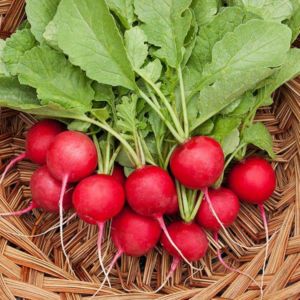 Its main feature is its ability to adapt to any conditions. He is not afraid of cold weather or heat. Suitable for growing in open ground in all regions of our country, for example, in Moscow.
Its main feature is its ability to adapt to any conditions. He is not afraid of cold weather or heat. Suitable for growing in open ground in all regions of our country, for example, in Moscow.
Gardeners love this type of radish for its large and juicy fruits. They have a balanced taste with a light, barely noticeable pungency.
Celeste is immune to culture-specific diseases. This property allows you to grow an environmentally friendly and safe product.
Advantages and disadvantages of Celeste
The popularity of Celeste is due to an extensive list of advantages with an almost complete absence of disadvantages. Thanks to this, even a novice gardener will not be difficult to cope with growing radishes.
Advantages of Celeste:
- early ripeness;
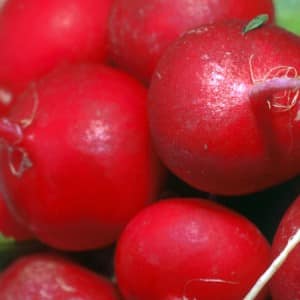
- immunity to diseases characteristic of radishes;
- high keeping quality of fruits;
- excellent taste and juiciness of root vegetables;
- resistance to temperature changes;
- ease of care;
- high germination of planting material;
- uniform ripening of root crops;
- absence of peduncles and arrows;
- Possibility of growing in open and protected ground.
The only drawback of Celeste is its hybridity: each time you have to use store-bought ones. seeds.
Note! A disadvantage common to all radishes is the ability to accumulate harmful substances from the soil in the roots. For this reason, it is not recommended to use chemicals to prevent diseases and pests.
Main characteristics
The parameters of the Celeste radish will appeal to beginners and experienced gardeners. It is thanks to them that this hybrid is grown not only on small plots of land “for oneself”, but also on farms for sale.
Characteristics and description of the hybrid:
| Options | Indicators |
| Ground part of the plant | The leaves are medium in size and deep green in color. Pubescence is present. The plant does not throw out flower stalks and shoots. |
| Roots | Round, aligned. The outside is red or bright pink. Smooth to the touch. The flesh inside is white and may have pinkish veins. The average weight of each root vegetable reaches 30 g. The pulp is juicy and aromatic. The taste has a slight pungency and sweetness. |
| Productivity | High. From 1 sq. m harvest up to 3.5 kg of fruit. |
| Ripening time | Early ripening.The harvest is ready for harvest 25-35 days after sowing the seeds. |
| Transportability | High. The fruits do not spoil when transported over long distances and remain juicy for more than 3 weeks. |
| Growing conditions | Easily adapts to any climatic conditions. Suitable for growing in open and protected ground. Cultivation in winter in heated greenhouses is possible. |
| Disease resistance | Is immune to most diseases. |
Rules of agricultural technology
Celeste radishes are grown in open ground or in a greenhouse. The crop is not afraid of cold weather and is grown from mid-March - early April to the end of October.
For radishes, choose well-lit or shaded areas of the garden on one side. It is advisable that they be protected from the wind.
Choose a site where cruciferous crops did not grow in the previous year: cabbage, watercress, horseradish, etc. Otherwise, the likelihood of plant infection increases.
Advice! Experienced gardeners recommend planting radishes in a new place every year.
The beds for the crop are prepared in the fall. They are dug up to a depth of 20-30 cm and cleared of all plant debris. Collected weeds and cultivated plants do not have to be thrown away. Some gardeners crush them, water them with a dark pink solution of potassium permanganate, and then bury them in the ground.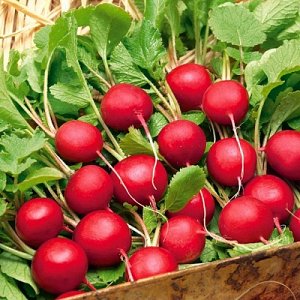
For every 1 sq. m of soil, add 6 kg of humus or manure. Fertilizers are thoroughly mixed with the soil.
Radishes love loose, slightly acidic soils. If the acidity level is increased, this is corrected by adding ash or dry lime. To make the soil more loose, it is mixed with sand.
In the spring, the beds are dug up again. They are cleared of weeds and leveled with a rake.Be sure to apply phosphorus-potassium fertilizers.
Some gardeners prefer to grow radishes in raised beds. In this case, the soil in the selected area of the garden is raised by 10-20 cm.
Preparing and sowing seeds
Radishes are grown without seedlings. Its seeds are sown immediately in open ground.
Note! Since this is not a variety, but a hybrid, seeds from self-grown plants are not suitable for sowing.
The first time planting material is sown in open ground at the end of March or beginning of April. The seeds will germinate at a temperature of +5 °C, but this will take a long time. At a temperature of +15 °C, seedlings appear much faster.
To speed up seed germination and increase the resistance of seedlings to adverse environmental factors, planting material is prepared. This process includes several stages: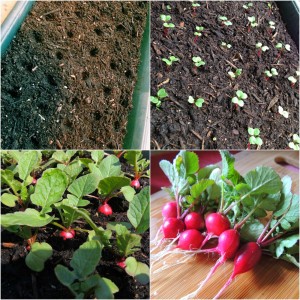
- The seeds are soaked in a glass of water, in which 1 tsp is dissolved. salt. After half an hour, the floating specimens are thrown out, and those that have sunk to the bottom are used for sowing.
- Planting material is soaked for 2 hours in a light pink solution of potassium permanganate. Instead, remedies sometimes use hydrogen peroxide (15 minutes) or Fitosporin (4-5 hours).
- Seeds are wrapped in pieces of gauze. They are placed in a deep container and watered with a growth stimulator (Epin, Zircon). The container is removed for 2 days in a warm place.
- Swollen seeds place in the refrigerator for 24 hours.
After preparation, begin sowing the seeds. Before this, the beds are watered in advance.
Furrows are made in the soil 2 cm deep. A distance of 15 cm is maintained between them.
Seeds are sown in the grooves at a distance of 4 cm from each other. They are sprinkled with soil on top, which is compacted slightly. This will prevent the planting material from being washed away.
The beds are watered with warm water and covered with film. It is removed when the seeds germinate.
Advice! Many gardeners sow radish seeds in the ground several times a season. This allows you to harvest up to 6 times during the summer and autumn.
Plant care
To get a good harvest of radishes, you need to properly care for them. Here are the basic rules that every gardener should know:
- The soil is moistened as the top layer dries. Warm water is used to irrigate the beds using the rain method. If there is not enough liquid, the fruits will turn out dry and bitter. If there is excess moisture, root crops will hurt and rot. The soil is moistened in the morning or at sunset, when the sun is inactive.
- After each watering, the soil is loosened to a depth of 4-5 cm. This will help normalize root air exchange and prevent the formation of an earthen crust that prevents moisture evaporation.
- During the growing process, the beds are loosened. This is done while the plants are young. Grown root crops will not allow weeds to develop.
- Experienced gardeners recommend mulching the beds with humus or straw. This will reduce the need to use fertilizers.
- When the first shoots appear, check the distance between them. If it is less than 4 cm, then the vegetation is thinned out.
- Radishes are not afraid of frost and can withstand temperatures down to -4 degrees. If it gets colder outside, the plants will die.
- If the soil is nutritious enough, fertilizing is not necessary. Fertilizers are applied to poor soil once. Natural ingredients are used. Silage is considered the best option. To prepare it, add a quarter of a bucket of chopped weeds and 1 kg of chicken manure, and the rest of the volume is filled with cold water. The mixture is infused for 4 days.Then water the plants using 1 sq. m 5 l.
Important! Gardeners do not recommend feeding radishes with manure. This is fraught with the formation of voids in the fruits.
The nuances of growing in a greenhouse
Gardeners grow radishes not only in open ground, but also in greenhouses. In summer agricultural technology is no different, except that the room must be regularly ventilated.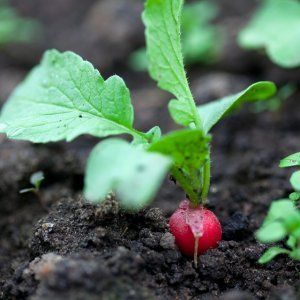
In winter, it is important to maintain the temperature regime in a heated greenhouse. The temperature in the greenhouse should vary between 20-25 °C.
Radish is a short-day plant. In winter, it is enough to turn on fluorescent lamps for 10-12 hours.
Plants in a greenhouse are watered less often than in open ground. Indoors, moisture evaporates more slowly. 1 watering per week is enough.
This is interesting! Radishes also grow well in pots at home. Due to insufficient space, it will not be possible to obtain a rich harvest.
Harvesting and storage
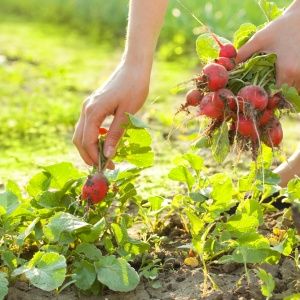
The ripening time of the Celeste radish depends on the outside temperature. If at the beginning of spring the harvest is harvested only 1.5 months after sowing the seeds, then at the beginning of summer the root crops are ready for consumption within 25-30 days.
When harvesting, radishes are completely pulled out of the ground. Cut off the tops, which contribute to the rotting of root crops.
For storage, select whole root vegetables without damage. They are wiped off the ground with a dry cloth. Store the harvest in a dry, dark and cool place.
This is interesting! Not only radishes are eaten, but also young tops. It is considered a useful ingredient for salads.
Prevention of diseases and pests
Celeste radish is resistant to cruciferous diseases. However, the rules of prevention should not be neglected:
- It is important to observe crop rotation. Radishes are not planted in beds after other cruciferous vegetables for several years in a row. Do not place beds with this crop near cabbage.
- Disinfection. Disinfecting solutions are used to treat planting material, beds before sowing, greenhouse walls and garden tools.
- Compliance with watering rules. Both soil waterlogging and drought promote the development of pathogens.
It is important to protect plants from pests. This is done as follows:
- Radish leaves are sprinkled with ash once a week.. This will protect the plants from small insects and slugs.
- Many radish pests feed on dry leaves. Therefore, greens need to be constantly moistened.
- If pests have already ruined the bushes, then they are sprayed with a soap solution. To prepare it, dissolve 1 piece of laundry soap in a bucket of water.
- Traps are set for slugs. To do this, rotten wood and wet cloth are placed between the rows. The pest traps are then collected and thrown away.
Read also:
Mid-season and unpretentious muscat variety of pumpkin “Kubanskaya”.
Reviews from gardeners
Reviews from gardeners about Celeste radishes are mostly positive. Gardeners note the high yield of the hybrid and its unpretentiousness.
Alisa, Moscow: “I’ve been growing Selesta radishes for several years now. A very productive hybrid. The seeds have almost one hundred percent germination. I don’t even sort through them, they all sprout. I fertilize radishes with silage, bread tincture and chicken droppings. In total I apply 1 fertilizing per season. I use not only root vegetables, but also young greens. It is suitable for salads and green cabbage soup.”
Alexander, Sochi: “I grow Celeste all year round.In spring, autumn and summer in open ground. In winter in a greenhouse. I use two beds. I sow radishes on them one at a time with an interval of 20 days. After each harvest, I always water the beds with hot copper sulfate. I add urea, superphosphate and potassium. I feed it with silage containing chicken manure. The harvest is excellent. Root vegetables are very tasty and juicy. There are practically no pacifiers. I will plant more."
This is interesting! Radishes are so unpretentious that they are even grown on space stations.
Conclusion
Radish Celeste is one of the most unpretentious and productive varieties. It quickly adapts to any climatic conditions. It is also distinguished by its high immunity to plant diseases.
The main advantages of the hybrid are high yield and early ripeness. Its sweet, juicy and slightly spicy fruits are harvested within a month after sowing the seeds. Celeste is worth the attention of beginners and experienced gardeners.